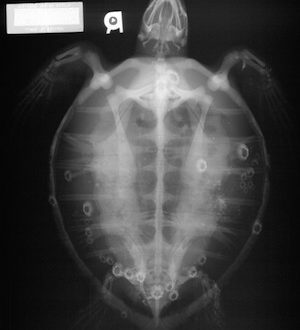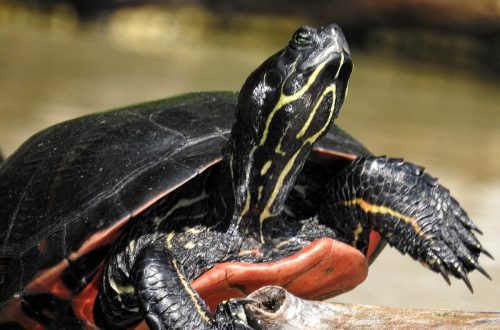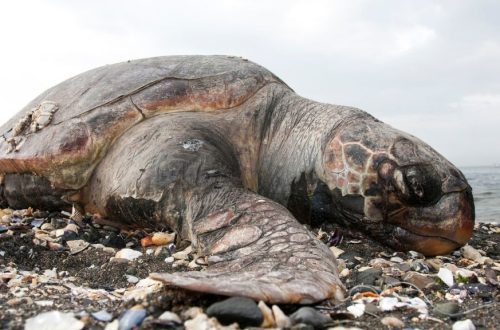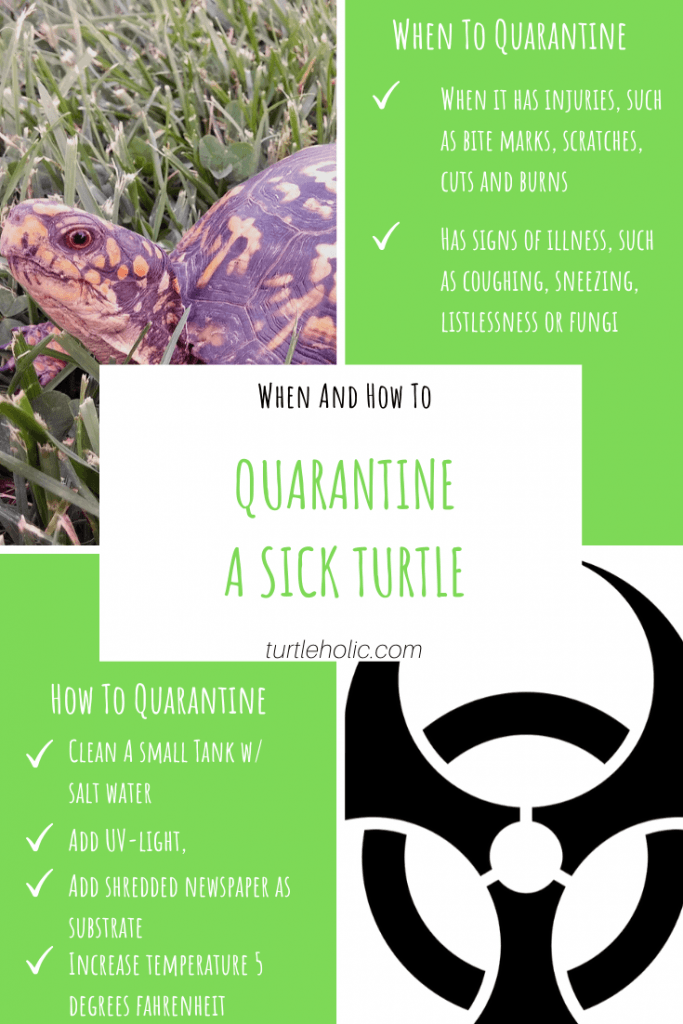
Turtle Quarantine and Disinfection
Quarantinetion is a set of measures aimed at preventing the introduction and spread of infectious diseases. Quarantine should be the first and mandatory step for any newly introduced animal. It is carried out in a separate terrarium, and until the end of quarantine, i.e. until the moment when there is complete confidence that the animal is healthy, other animals are not placed in this terrarium. The term of quarantine is usually 2-3 months. If after this period the animal looks good and there are no deviations in its analyzes (for worms and bacteria), then it can be transferred to keeping with other animals. But usually 2-4 weeks are left for quarantine.
To identify diseases, an examination is carried out, which includes: – assessment of the appearance of the animal and its fatness (exhaustion, obesity, deformation of the limbs, shell, visible tumors, open wounds, abrasions, changes in the claws, clouding of the cornea, swelling of the eyelids, bulging of the eyeball, skin parasites, etc.); – inspection of hidden places of the most frequent location of parasites (skin folds, spaces under the carapace or above the plastron, cloaca); – examination of accessible cavities (mouth, nasal passages, cloaca – hemorrhage, prolapse, discharge, the presence of worms and larvae). – palpation, listening (conducted by a veterinarian). When observing an animal in quarantine, attention is paid to its behavior, food activity, frequency and nature of molts. Can be identified – lethargy, constant avoidance of heat, increased mobility, convulsions, impaired coordination of movements, impaired flotation (diving in aquatic turtles). With these signs of disease, you should contact your veterinarian.
The quarantine container is a plastic basin for water turtles and any box with bedding (white paper, paper napkins, rug) for land turtles. Temperature, heating, lamps are the same as for non-quarantine animals. Turtles in quarantine are fed in the same way as ordinary turtles, but only after healthy turtles, in order to prevent the transfer of a possible infection.

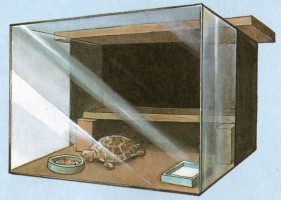
What is quarantine? You sit all alone Are watching you To be you, not sick. Did you eat well So that the tongue does not turn yellow. It matters how you poop Maybe you have worms… A clear look and a clean shell … Do you hear a whistle when you breathe? Quarantine is given to us To then get to friends
(author Julia Kravchuk)
Disinfection measures for the most common infectious diseases
Preventive:
– irradiation of the terrarium and the room in which it is located with ultraviolet rays or quartzization (in the absence of a turtle); – timely cleaning of feces, food residues, change of water and contaminated soil; – washing of all equipment in the terrarium.
General disinfection:
– the feces of sick animals are covered with bleach in a ratio of 1: 1 for 5 hour, after which they are thrown away; – drinking cups are boiled for 15 minutes in 1% solution of chloramine, 3% solution of hydrogen peroxide, and then washed with clean water and dried; – the terrarium and equipment are treated 2 times a day with a cloth soaked in 30% hydrogen peroxide solution with detergent; – after cleaning, the garbage is poured with 10% solution of bleach; – the walls of the terrarium are irrigated with 10% solution of chloramine from a spray bottle, irradiated with UV rays and the soil is changed; – Animal care items are immersed in 1% solution of chloramine or in clarified solution of bleach for 1 hour. At the end of disinfection, hands should be thoroughly washed with 10% solution of chloramine for 1-2 minutes.
salmonellosis
Allocations of a sick animal – Fall asleep with dry bleach in a ratio of 1: 5, mix and leave for an hour, after which they are poured into the sewer. Food residues – Diluted with water in a ratio of 1: 1, covered with dry bleach in a ratio of 1: 5, mixed and left for an hour, after which they are poured into the sewer. Drinkers – Boil in a 1% soda solution for 15 minutes and immerse for 30 minutes in a 0,5% solution of chloramine, 3% hydrogen peroxide solution, washed, dried. Terrarium, equipment – Clean with a damp cloth at least 2 times a day, after cleaning the garbage is poured with a 10% solution of bleach. During the final disinfection, the walls of the terrarium are irrigated with a 1% solution of chloramine and the soil is changed. Animal care items – Immerse for 1 hour in a 1% solution of chloramine or in a clarified solution of bleach. Hands – After each contact, wash in a 0,5% solution of chloramine for 1-2 minutes, then with soap.
Mycosis
Descended shields and creeps – Pour for 2 hours with a 10% solution of bleach or a 5% solution of disol, then discard. Drinkers and tools – Boil for 15 minutes in a 1% soda solution, or immerse for 15 minutes in a 10% formalin solution. Terrarium, equipment – Treat with a 1% solution of activated chloramine, change the soil.
Bacteria of the genera Aeromonas, Pseufomonas, Staphilococcus
Drinkers and tools – Boil for 15 minutes in a 1% soda solution, or immerse for 30 minutes in a 1% solution of chloramine or 3% hydrogen peroxide solution with a detergent, wash with hot water and dry Terrarium, equipment – Wet cleaning at least 2 times a day with a 3% hydrogen peroxide solution with detergent, direct ultraviolet irradiation and soil change. To disinfect the terrarium, it is best to use the following products: Septabik, Bromosept, Virkon, “Effect-forte”. More…
Infectiousness
How not to infect a second turtle if one is sick?
A sick turtle should be placed in “quarantine”, and also do not forget to carry out disinfection measures. Do not allow turtles to contact each other, and also first manipulate a healthy turtle, and only then with a sick turtle.
Can a cat or other animal infect a turtle?
According to our data, mammalian diseases are not contagious to turtles, unless it is salmonellosis.
Can a human infect a turtle?
Theoretically, it can only infect with salmonella.
Are turtle diseases transmitted to humans?
1. Only one turtle disease, salmonellosis, is contagious and is transmitted to both birds and humans. The disease in humans is quite difficult, but, fortunately, turtles do not get sick of it often. The first signs of salmonella are easily identified in turtles by a sharp-smelling greenish feces. If you are afraid that your pet is sick, it is better to use rubber gloves, and take the turtle to the veterinarian as soon as possible. Some extremely rare diseases of turtles, such as viral papillomatosis, can also be contagious. 2. Turtles do not cause allergies, but unlike dry food, which is often fed to turtles, as well as fish, seafood, meat. It is theoretically possible to be allergic to turtle feces. 3. Cases when turtles caused infection of humans with fungal diseases have not been identified.
I’m pregnant and I have turtles. This is not dangerous?
In all turtles, salmonella is a conditionally pathogenic microflora, which is activated under severely unfavorable conditions, when the turtle’s body is greatly weakened. Other diseases from turtles are not transmitted to humans. Although the chance of infection is very small, for the best protection, it is better to use rubber gloves during pregnancy and wash your hands with soap and water after contact with turtles or aquarium equipment. It is not necessary to get rid of the turtle in case of pregnancy!



